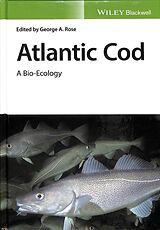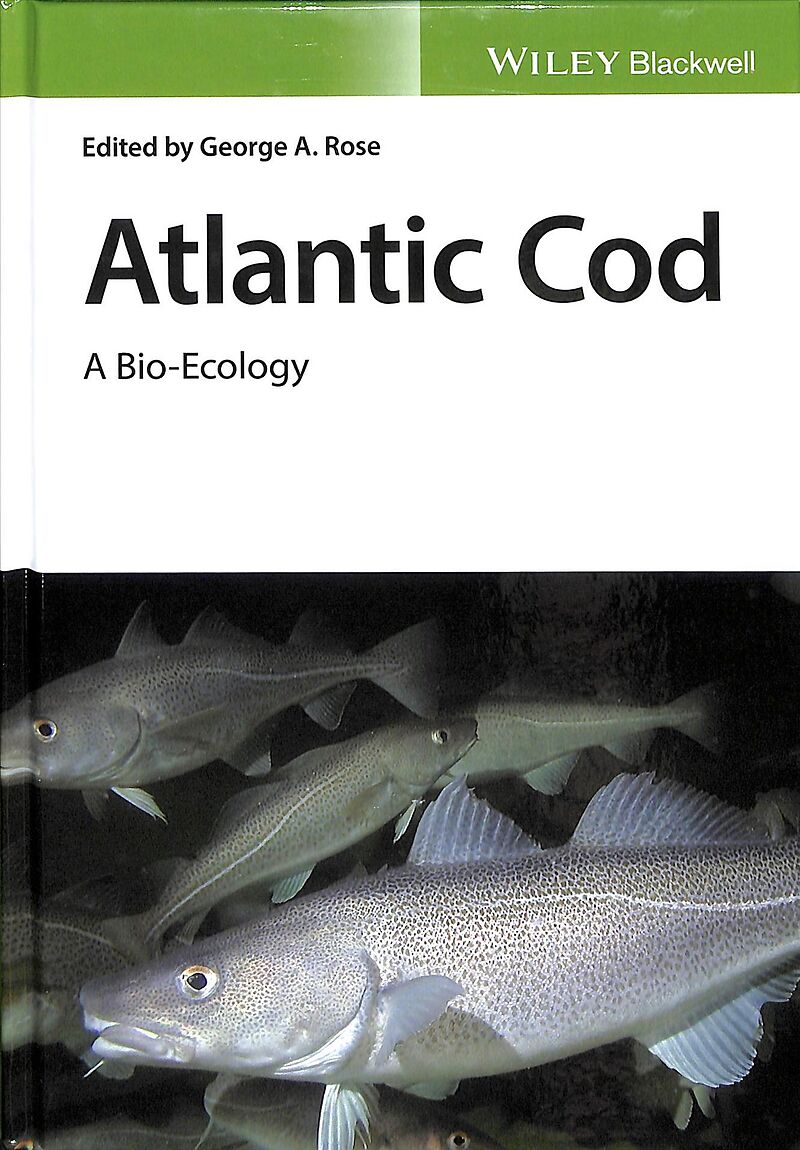Atlantic Cod
Einband:
Fester Einband
EAN:
9781405119108
Untertitel:
A Bio-Ecology
Genre:
Biologie
Autor:
George A. Rose
Herausgeber:
Wiley
Auflage:
1. Auflage
Anzahl Seiten:
416
Erscheinungsdatum:
01.03.2019
ISBN:
978-1-4051-1910-8
Autorentext
George A. Rose is a Canadian fisheries scientist, retired from Memorial University of Newfoundland and currently an Honorary Professor at the Institute for the Oceans and Fisheries, University of British Columbia, Vancouver, Canada.
Klappentext
A comprehensive handbook, covering all aspects of the Atlantic cod including the biology, ecology, life histories, behaviour, commercial exploitation and conservation Not only is Atlantic cod one of the most valuable food fish in the world's oceans, it is an important component of North Atlantic ecosystems and has been subject to much research into its biology, ecology and exploitation. After hundreds of years of exploitation, overfishing in the last half of the 20th Century caused many stocks to collapse, most famously the Northern cod stock off Newfoundland and Labrador, Canada. Since then, most cod stocks have been better researched and managed, but remain in a variety of states, from fully recovered to continued decline. This book, written by world experts, describes that research and management, and the importance of cod and its fisheries on North Atlantic cultures and economies, with impacts well beyond the range of the species. Atlantic Cod: Bio-Ecology of the Fish offers insightful chapter coverage of cod nomenclature, taxonomy, phylogeny and morphology; physiology and ecophysiology; reproduction and spawning behavior; early life history and pre-recruitment processes; migrations, movements and stock identity; feeding, growth and energetics; the place of cod in the ecosystem; the exploitation of cod through history and present day commercial fisheries and precautionary management for sustainable fisheries; impacts of climate change on cod biology and ecology; and the future of the species and its fisheries. * Discusses the major commercial importance of Atlantic cod through history * Provides a comprehensive treatment of the bio-ecology of the most researched and highly exploited fully marine species * Examines how the decline (and recovery) of cod stocks is of great political and scientific interest * An essential purchase for marine fisheries scientists Atlantic Cod: Bio-Ecology of the Fish is a vital book for all fisheries scientists, managers and fish biologists.
Zusammenfassung
Not only is the cod one of the most valuable marine food fish, it is also important as a predator in ocean ecosystems and is the subject of a great deal of research into its biology and exploitation. Because of its significance, there is currently much research being carried out into farming of cod.
Inhalt
Preface xi List of Contributors xiii Atlantic Cod: A Bio-Ecology 1 Introduction 1 1 Atlantic Cod: Origin and Evolution 7 Gudrun Marteinsdottir and George A. Rose 1.1 Introduction 7 1.2 Taxonomy and Morphology 9 1.3 Origin and Evolution 9 1.4 Cod: One of Few Endemic Atlantic Species 11 1.5 The Ancient North Atlantic: Dispersal and Early Population Structure 12 1.6 Rise of Cod and Current Population Structure 13 1.7 Is Diversity a Key to Cod's Success? 16 1.8 The Genetic Seascape 17 Bibliography 20 2 Ecophysiology 27 Denis Chabot and Guy Claireaux 2.1 Introduction 27 2.2 Temperature 31 2.2.1 Thermal Physiology 31 2.2.2 Thermal Niche of Cod 33 2.2.3 Temperature Range for Different Cod Stocks 33 2.2.4 Thermal Preferendum in the Laboratory 34 2.2.5 Temperature and Cod Growth 34 2.2.6 The OCLTT Hypothesis and Cod 36 2.2.7 Lethal Temperature for Cod: The Effect of Acclimation 37 2.2.8 Aerobic Metabolic Scope of Temperature-Acclimated Cod 38 2.2.9 Temperature and Cod Recruitment 40 2.2.10 Temperature Adaptation in Cod 41 2.3 Dissolved Oxygen 42 2.3.1 Hypoxia 42 2.3.2 Respiration 42 2.3.3 Responses of Fishes to Hypoxia 43 2.3.4 Hypoxia Exposure of Cod Populations 45 2.3.5 Survival of Cod in Hypoxia 48 2.3.6 Impact of Hypoxia on Cod Recruitment 48 2.3.7 Impact of Hypoxia on Cod Distribution 48 2.3.8 Cod Performance in Hypoxia 49 2.3.9 Hypoxia and Feeding of Cod 49 2.4 Salinity 50 2.4.1 Osmoregulation in Marine Fishes 50 2.4.2 Salinity Tolerance of Cod 51 2.4.3 Salinity and Growth Rate of Cod 51 2.4.4 Interactions Between Ambient Salinity, Temperature and Oxygen 52 2.4.5 Salinity Selection by Cod 53 2.4.6 Salinity and Cod Recruitment 53 2.5 Water pH 55 2.5.1 Causes of Ocean Acidification 55 2.5.2 Physiological Impacts of Ocean Acidification 55 2.5.3 Cod and Higher Carbonate Solubility 56 2.5.4 Cod Acid-Base Regulation 56 2.5.5 Acidification and Performance 56 2.5.6 Interaction Between pH and Hypoxia 57 2.6 Other Environmental Variables 57 2.6.1 Light 58 2.6.2 Contaminants 58 2.6.3 Trophic Interactions 60 2.6.4 Parasites and Diseases 61 2.7 Applications of Ecophysiological Understanding 62 2.8 Conclusions 64 Acknowledgements 64 Bibliography 65 3 Reproduction and Spawning 87 Peter J. Wright and Sherrylynn Rowe 3.1 Summary 87 3.2 Introduction 87 3.3 Variation in Maturation 89 3.4 Reproductive Investment 94 3.5 Spawning Location 100 3.6 Spawning Time 107 3.7 Spawning Behaviour 110 3.8 The Future 116 Acknowledgements 116 Further Reading 117 Bibliography 117 4 Early Life History 133 Timothy B. Grabowski and Jonathan H. Grabowski 4.1 Introduction 133 4.2 Early Development of Atlantic Cod 135 4.2.1 Life in the Plankton 137 4.2.2 'Bottoming out' - Settlement and Juvenile Habitat Use 149 4.3 Mortality 153 4.4 Feeding and Growth 155 4.5 Habitat Shifts, Dietary Shifts, and Growing Up 157 4.6 Conclusions 157 Acknowledgements 158 Bibliography 158 5 Migration 169 David Righton and Julian Metcalfe 5.1 Introduction 169 5.2 Why Migrate? 170 5.3 Studying Migration: What We Need to Know and How We Learn 173 5.3.1 Tagging and Marking Experiments 174 5.3.2 Natural Marks - Meristics, Parasites, and Chemical Composition 174 5.3.3 Artificial Marks - Simple Tags 175 5.3.4 Artificial Marks - Electronic Tags 177 5.4 Mechanisms of Migration 179 5.4.1 Swimming Behaviour 179 5.4.2 Use of Currents 180 5.4.3 Migration Pathways 181 5.4.4 Migrations and Populations 181 5.5 Cod in the Western Atlantic 182 5.5.1 Gulf of Maine and Georges Bank 186 5.5.2 Scotian Shelf and Southern Newfoundland 187 5.5.3 Gulf of St Lawrence 189 5.5.4 Grand Banks 190 5.5.5 Labrador Shelf and Eastern Newfoundland 190 5.6 Cod at Iceland and Greenland 192 5.6.1 Movements of Cod from Greenland to Labrador 195 5.7 Cod in the Eastern Atlantic 195 5.7.1 Barents Sea/ Norwegian Coast (Arcto-Norwegian Cod) 195 5.7.2 The North Sea 197 5.7.3 The Baltic 198 5.8 The Importance of Oceanographic, Physiological, and Evolutionary Influences on Cod Migration and Stock Structure 200 5.9 What of the Future? 203 Bibliography 204 6 Feeding, Growth, and Trophic Ecology 219 Jason S. Link and Graham D. Sherwood 6.1 Summary 219 6.2 Introduction 219 6.3 Feeding: What and How 222 6.3.1 Cod Feeding Behaviour and Energetic Consequences 224 6.3.2 Compared to Other Predators 226 6.3.3 Research Remaining and Further Work 226 6.4 Feeding: How Much? 227 6.4.1 Estimating How Much Cod Eat 227 6.4.2 Magnitude of How Much Cod Eats 230 6.4.3 Research Remaining and Further Work 231 6.5 What Happens to the Food Cod Eat: Losses and Metabolism 231 6.5.1 Egestion 232 6.5.2 Specific Dynamic Action 232 6.5.3 Excretion 233 6.5.4 Standard Metabolism (Respiration) 234 6.5.5 Activity 234 6.5.6 Summary of Metabolic Costs 235 6.5.7 Research Remaining and Further Work 237 6.6 What Happens to the Food Cod Eat: Individual Growth 237 6.6.1 How Is Growth Measured? 238 6.6.2 Reporting Growth and Variability in Growth 239 6.6.3 Condition Indices 242 6.6.4 Climate Change Effects on Growth 246 6.6.5 Summary 249 6.6.6 Research Remaining and Further Work 249 6.7 What Happens to the Food Cod Eat: Population Growth via Reproduction 250 6.7.1 Maturity 250 6.7.2 Fecundity 253 6.7.3 Realizing Reproductive Potential Through Feeding 254 6.7.4 Summary 255 6.7.5 Research Remaining and Further Work 256 6.8 What Happens to the Food Cod Eat: Population …

Leider konnten wir für diesen Artikel keine Preise ermitteln ...
billigbuch.ch sucht jetzt für Sie die besten Angebote ...
Die aktuellen Verkaufspreise von 6 Onlineshops werden in Realtime abgefragt.
Sie können das gewünschte Produkt anschliessend direkt beim Anbieter Ihrer Wahl bestellen.
Loading...
Die aktuellen Verkaufspreise von 6 Onlineshops werden in Realtime abgefragt.
Sie können das gewünschte Produkt anschliessend direkt beim Anbieter Ihrer Wahl bestellen.
| # | Onlineshop | Preis CHF | Versand CHF | Total CHF | ||
|---|---|---|---|---|---|---|
| 1 | Seller | 0.00 | 0.00 | 0.00 |
